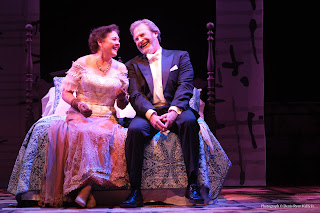German string quartet makes local debut, bringing expansive Grieg to light
The plethora of excellent string quartets can put its signature on an immense literature,
 |
| Goldmund Quartet: Wide-ranging, yet fond of Bavarian roots |
drawing upon relatively neglected works as well as familiar treasures of the repertoire.
In making its local debut Wednesday night under Ensemble Music Society auspices, the Goldmund Quartet intrigued immediately on paper with the placement of Edvard Grieg's only string quartet occupying the concert's second half alone.
With a decent amount of widespread respect, the Norwegian composer has been hemmed in by a reputation as an exquisite nationalist with limitations suggested by his achievement in short-form composition. In contrast, there is chiefly the well-established piano concerto, often honored by its inclusion on the LPs of yore with Robert Schumann's counterpart in the same key of A minor. But it's worth considering that his craftsmanship could come up with the expansive splendor of the String Quartet in G minor, his only completed effort in that genre.
The group's web site indicates this work's strong presence on its current season. Wednesday night it was performed with the requisite breadth of expression and an ensemble unanimity that persisted throughout its four movements. The themes are extensively interwoven, and the composer's inclination toward the folk dances of Norway is demonstrated in both miniature and development.
There is a recurrent ferocity from the start, and the Goldmund lifted the intense moods up when called for. Yet the young Germans never sounded too forceful, but fitted such intensity into an overall conception of the music that linked the lighthearted and lyrical episodes to everything else. The variegated spirit of '"Peer Gynt," the Ibsen play for which Grieg wrote incidental music whose immortality has been assured in a couple of suites, was vividly represented.
The finale stunned in the way it rose from genuine grandeur to grandiosity: Grieg was clearly apt for making outsized statements when the mood struck him. The conclusion was bound to elicit a standing ovation.
But so had the group's demonstration of the core of the string quartet in Haydn's Quartet in F major, op. 77, no. 2, just before intermission. At the crowning stage of his mastery, Haydn displayed the independence he could give to each of the instruments while fashioning a unified effect. The way he opened the third movement with a gentle march shared by first violin (Florian Schṏtz) and cello (Raphael Paratore) brought out the security of tone and pace the Goldmund presented regularly. The signature Haydn wit was delightfully brought forward near the end of the work, chiefly through Paratore's pixieish articulation.
The concert opened with a short, characteristic Shostakovich work — dour, rhythmically acute, and melodically ironic. The Russian composer's No. 7 in F-sharp minor gave the audience an immediate taste of the richness of tone, even in staccato playing, that the Goldmund can draw from their matched Stradivarius instruments. The set, named for Niccolo Paganini, the Italian virtuoso who once owned them, had also been played here by the Tokyo and Cleveland string quartets. Elsewhere, when the music abruptly breaks into harsh episodes, the Goldmund players and their fine instruments were displayed with similar brilliance.
Called back for encores after that impressive Grieg performance, the Goldmunders drew upon their Bavarian heritage, first with Herbert Pixner's ingratiating "Augenstern," then with a strong hint of Oktoberfest in Munich, welcoming hand claps and applying demonstrative foot-stomping.
I overheard one audience member say, "It seems like we should be lifting beer steins here." In any case, and not just for the sake of gemȕtlichkeit, the Goldmund Quartet proved well worth a hearty toast in the spirit of Hoosier hospitality. Prosit!


Comments
Post a Comment